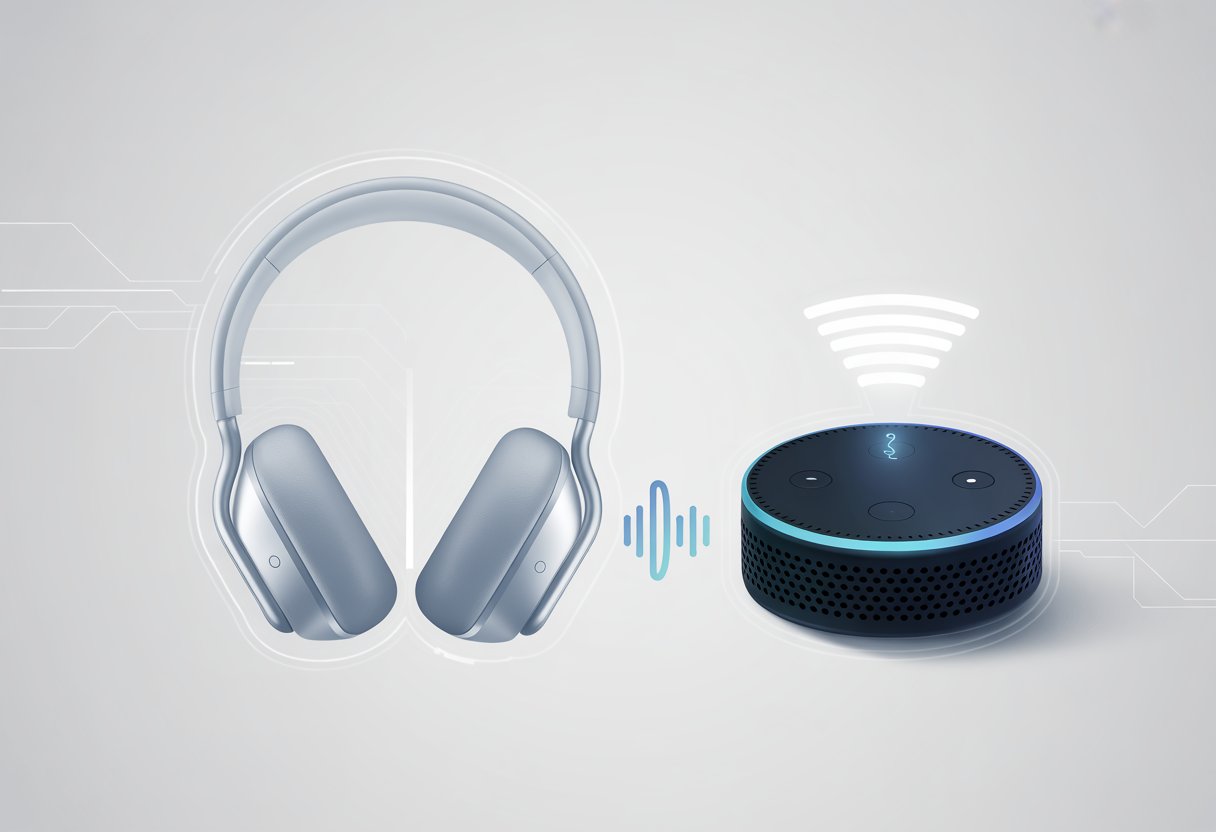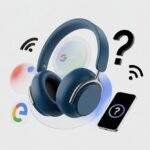We’ve all been there—sitting with our shiny new Bluetooth headphones, ready to bark commands at Alexa like we’re living in a sci-fi movie. But nope, Alexa just sits there giving us the silent treatment.
The real reason our Bluetooth headphones might not work with Alexa is that not all headphones use a supported Bluetooth profile or have the right software updates to make friends with Amazon’s voice assistant.

It sounds simple, but when the headphones we love aren’t on speaking terms with Alexa, it’s just plain annoying. Sometimes, it feels like our gadgets have cliques and our devices missed the invite.
We might even wish our headphones had a “make Alexa work” button. If only tech could be that easy.
Until then, let’s break down what’s really going on with this Bluetooth drama. Maybe we can fix it, or at least get some answers before yelling at our headphones again.
Understanding Alexa Compatibility with Bluetooth Headphones
Not all Bluetooth headphones play nice with Alexa, even if we want everything to just magically work together. Let’s talk about how Alexa and headphones try—sometimes awkwardly—to connect, what needs to line up, and the not-so-secret differences between voice assistants that trip us up.
How Bluetooth Headphones Integrate with Alexa
When we try to connect our headphones to Alexa, we’re usually just dealing with Bluetooth pairing. This lets us use our headphones as wireless speakers for Echo devices or our phones with the Alexa app.
Before we get too excited, Bluetooth headphones don’t always let us use every Alexa feature. Standard Bluetooth gives us music and audiobooks, but not all models support Alexa’s voice controls or things like hands-free calling.
Some headphones are “Alexa built-in”—those have microphones and special integration for voice commands. If our headphones don’t show up or act weird, unsupported Bluetooth profiles could be the culprit.
Not every set of headphones speaks “Bluetooth” the same way Alexa does. It’s worth double-checking compatibility.
If you want more on connectivity tips, there’s a good breakdown on pairing headphones and Bluetooth issues.
Core Requirements for Alexa Support
Alexa compatibility isn’t just plug and play. Our headphones need to check a few boxes:
- Supported Bluetooth Profile: Headphones should use a common Bluetooth profile, like A2DP or HFP, which Alexa supports.
- Microphone Access: For voice commands, built-in microphones are a must. Not all Bluetooth headphones share their mic data properly.
- Firmware Updates: Alexa and our headphones need to run the latest software. Old gadgets can be stubbornly silent.
- Specific Alexa Features: Hands-free “Alexa” wake words work only on headphones with “Alexa built-in.” Basic Bluetooth ones just won’t do it.
If our headphones don’t meet these, we’ll probably just get music—no deep “conversations” with Alexa.
Voice Assistant Differences
Not all assistants are built the same. Our Bluetooth headphones might work perfectly with Siri or Google Assistant, but Alexa doesn’t always join the party.
Alexa needs special permissions and software tweaks to use device microphones through headphones. We might find our headphones let us talk to Siri or Google by long-pressing a button, but Alexa just ignores us—even after we’ve paired everything twice and tried shouting politely.
This mismatch isn’t Alexa being rude. Different platforms just handle their assistants differently, which can make things confusing and, honestly, a bit frustrating when switching brands.
If you want step-by-step help, the Amazon forum on pairing Bluetooth headphones has some extra details.
Common Reasons Bluetooth Headphones Don’t Support Alexa
Bluetooth headphones can be picky about which features they offer, especially with Alexa. Sometimes hardware, design, or software just isn’t up for it, and our smart headphone dreams take a little tumble.
Lack of Built-In Alexa Functionality
Not all Bluetooth headphones come with the magic ingredient: built-in Alexa. Many headphones just weren’t designed for chatting with a virtual assistant, so their hardware can’t handle the extra tech.
Some brands focus only on music and calls, not voice-controlled assistants. That means no microphone setup or built-in skills for Alexa.
Even if the headphones pair with our phone, Alexa can’t listen or respond unless the device has the right hardware and software. If we want Alexa to answer, we need headphones that actually advertise “Alexa built-in” or at least mention voice assistant support.
Otherwise, we’re just talking to a fancy headband.
Missing Action Button
Headphones need a way to tell Alexa, “Hey, listen up!” The famous “action button” usually wakes Alexa on dedicated devices.
If our headphones skip this button (maybe for that sleek, minimalist look), we’re left shouting “Alexa!” into the void. On Alexa-friendly headphones, pressing the action button signals Alexa to listen.
No such button? Or just volume and track skip buttons? Alexa doesn’t even know we’re trying.
Designers sometimes leave out the action button, thinking we’ll just use voice or tap the phone. Unless the software can make up for missing hardware with touch or gesture controls, we’re usually out of luck.
Voice Guidance Limitations
Voice guidance is supposed to help—give us tips, status updates, or Alexa’s robotic voice. But some headphones skip this feature or only offer the basics.
If headphones can’t tell us what’s happening, pairing and using Alexa becomes a guessing game. Older models or budget chips might not process Alexa’s voice responses or microphone access well.
Software version can matter too. Without updates or newer protocols, voice guidance can be limited or glitchy.
Some headphones just beep or “ding” instead of talking. When this happens, we’re left wondering if Alexa even heard us, or if we just said something embarrassing to a piece of plastic.
For more troubleshooting info, check Amazon’s Bluetooth issues guide.
Device Compatibility Challenges
Getting our Bluetooth headphones to play nice with Alexa should be simple. Sometimes, though, it feels like building IKEA furniture without the manual.
Problems usually start with the phone we use, the Bluetooth version in our gadgets, or how often we actually hit “update.” Let’s peek behind the curtain and see what’s usually going wrong.
Smartphone OS Barriers
When we try to connect Bluetooth headphones with Alexa, our phone’s operating system jumps in. Android and iOS each act a little differently, and not all Alexa features work the same.
If we’re on a quirky or old Android version, it might ignore certain connection requests completely. iOS can be just as stubborn, sometimes hiding settings behind weird menus or multiple password prompts.
Some Bluetooth devices only work with Alexa if we use a specific OS version or update. Keeping our phones or tablets updated is way more useful than guessing the Wi-Fi password at a friend’s house.
Older Android and iOS versions might not support the right permissions, leaving Alexa and our headphones in different social circles.
Bluetooth Version Issues
Bluetooth comes in different versions—like ice cream flavors, but less tasty. Our headphones and Alexa device need to speak the same “language” to pair up.
If one device is stuck on Bluetooth 3.0 and the other wants 5.0, we’re asking for trouble. Or at least, a lot of silent headphones.
Even when both devices claim “Bluetooth support,” their profiles might not match. Alexa looks for certain Bluetooth profiles for streaming and hands-free calls.
If our headphones don’t support what Alexa needs, it’s a no-go. It’s like trying to charge a phone with a spaghetti noodle.
Some people see spotty connections or random dropouts when Bluetooth versions clash. It’s like trying to chat with someone who only speaks in emojis.
Software and Firmware Outdatedness
Software updates are like vegetables—we know we should do it, but we don’t always get around to it. If our Alexa software, headphone firmware, or phone’s OS is out of date, we might hit connection problems or bugs that drive us nuts.
Alexa updates itself, but our headphones and phones usually don’t. If the manufacturer never pushes updates (or we avoid them), old firmware can cause issues with pairing or voice controls.
This happens a lot, especially with lesser-known brands or older headphones. Sometimes, a quick update can save hours of pointless troubleshooting.
If our devices can’t even recognize each other, it’s probably not personal—they’re just living in the past. For more on these classic Bluetooth letdowns, check out this Amazon troubleshooting page.
App and Setup Obstacles
Sometimes it feels like connecting Bluetooth headphones to Alexa is harder than remembering every streaming password we’ve ever made. There’s more going on than just Bluetooth pairing—think app quirks, regional blocks, and troubleshooting that leaves us scratching our heads.
Alexa App Configuration Problems
It’s almost a rite of passage to wonder if we set up the Alexa app right, especially on a new phone. The app tries to help, but it has its own quirks.
Some Android devices just don’t play nice with the Alexa app, causing it to skip or not see our Bluetooth headphones during setup. Even when our headphones are charged and sitting right next to our Echo device, the Alexa app sometimes fails to detect them.
Certain headphone models use Bluetooth profiles Alexa doesn’t recognize. If the headphones aren’t supported, Alexa acts like we’re invisible.
Double-checking device compatibility and updating both the Alexa app and device software is always a good idea—unless we just like yelling at our phone.
Account and Region Restrictions
Let’s get into regions and account settings—because, honestly, who expected that to be the problem? Alexa features shift depending on which country our Amazon account calls home. Sometimes, Bluetooth audio support just never shows up in certain places. It’s like everyone else is jamming out wirelessly while we’re stuck on the sidelines.
If we’ve moved or tweaked our regional settings recently, Alexa might get lost. Suddenly, some headphone features disappear or we can’t add new devices at all. Before we curse our headphones or hit the factory reset button in the middle of the night, it’s worth checking the supported regions and device features list.
Connection Help and Troubleshooting Steps
When nothing else works, we end up troubleshooting, hoping for a miracle. First, let’s make sure our headphones are charged, in pairing mode, and sitting right next to the Echo—almost uncomfortably close.
We also need to check if our Echo’s software is up to date. Alexa can get moody if we skip updates.
If we’ve paired these headphones before and now they’re ignoring each other, we should “forget” the old connection and start over. Amazon’s troubleshooting steps suggest removing the Bluetooth device, restarting everything, and crossing our fingers. Sometimes, pure stubbornness works. Sometimes, it just feels like our tech has a personal vendetta.
Feature and Language Limitations
Sometimes, Alexa and our Bluetooth headphones just can’t seem to get on the same page. This usually isn’t a plot by the headphone companies—it’s more about language or region settings that decide what Alexa can control.
Supported Languages for Alexa Voice Control
Alexa might live in the cloud, but she’s picky about languages. Not every supported language gets the full feature set on Bluetooth headphones.
If we’re using anything other than English, German, or Japanese, we might notice features are missing or just work whenever they feel like it.
Here’s a quick rundown of languages that usually play nice with Alexa:
| Language | Voice Control | Extra Features |
|---|---|---|
| English | Full Support | Most Available |
| German | Full Support | Most Available |
| Japanese | Full Support | Some Limitations |
| French/Spanish | Limited Support | Limited |
Trying other languages? Alexa’s sense of humor drops fast, and features start disappearing. Suddenly, asking for the weather in Dutch becomes a weird guessing game.
Regionally Limited Functions
Alexa doesn’t travel well. Certain things—like music streaming, voice shopping, or location-based reminders—only show up in select regions.
So if our country isn’t on Alexa’s “approved” list, those features just don’t show up, no matter how nicely we ask.
Trying to stream music or get traffic updates in an unsupported country? It’s about as effective as asking a goldfish for directions. For the gritty details on region-locked features, check the Amazon Customer Service page.
If a feature goes missing when we travel or move, it’s probably just not available where we are yet.
Bluetooth Connectivity Problems
Sometimes, connecting Bluetooth headphones to Alexa feels like trying to land a spaceship—except with more confusion and less success. Let’s dig into why those stubborn headphones refuse to cooperate, especially when interference, pairing, or electronics drama gets involved.
Wireless Network Interference
Wireless networks are chaos when too many signals crowd the air. Our homes buzz with Wi-Fi routers, smart TVs, and even microwaves (the popcorn MVP).
All these signals can mess with Bluetooth connections. If our headphones sit near a wireless router, we’ll notice dropouts in a flash.
Thick walls, metal junk, or even that ancient computer can block signals. Sometimes, just moving a device a few feet makes everything work again.
We should keep Bluetooth headphones and the Alexa device close, away from all that wireless clutter. If things still glitch, try turning off a few gadgets like TVs or computers. It’s not a perfect fix, but it beats yelling at Alexa.
Pairing Issues with Mobile Devices
Pairing is supposed to be simple—until it isn’t. Our phones love to cling to our headphones and ignore Alexa’s attempts to join the party.
To fix this, unpair the headphones from other devices first. Then, put the headphones in pairing mode and give Alexa another shot.
The Alexa app’s “Add Device” option usually helps, but sometimes it can’t find any Bluetooth devices at all. We’re not alone—forums are full of people with the same problem, trying everything from restarting to updating apps or just trying again with more hope (and coffee).
If frustration kicks in, patience is key. Often, rebooting both the headphones and Alexa device will clear things up.
Compatibility with Other Electronics
Bluetooth headphones and Alexa sometimes act like sitcom characters who just can’t get along. Not all headphones are built for this, and compatibility can ruin the whole experience.
Some headphones work only with computers or phones and don’t support the profile Alexa wants for audio. Smart TVs, recorders, or other Bluetooth speakers can hog the connection, leaving our headphones out in the cold.
It’s best to stick with headphones that are officially compatible with Alexa devices. Turning off other electronics nearby during pairing helps too.
If in doubt, check the details in manuals or on manufacturer websites. It can save us from another round of “Bluetooth Headphones Won’t Connect.” And if nothing works, Amazon’s Bluetooth troubleshooting tips might have something new to try.
Comparing Alexa with Other Voice Assistants
Let’s be honest: not all voice assistants are equal, and our headphones seem to know it. Some headsets love Alexa, some prefer Google Assistant, and a few just ignore us completely.
Differences Between Alexa and Google Assistant
When we use Alexa on headphones, she’s got rules. We need the Alexa app, and sometimes a bit of luck to get Bluetooth pairing working.
Google Assistant usually makes life easier. It often works right out of the box on Android devices and is built into many phones.
Alexa rules the Amazon world—think shopping lists, reminders, and smart home controls. Google Assistant is better at web searches and random trivia, and it fits right in with Google services like calendar and maps.
Some headphones even add a special button for Google Assistant, but to get Alexa, we might have to work harder—or just yell a little louder.
| Feature | Alexa | Google Assistant |
|---|---|---|
| Native on most phones | ❌ | ✔️ |
| Easiest to set up with headphones | ❌ | ✔️ |
| Best with Amazon devices | ✔️ | ❌ |
| Fun with shopping lists | ✔️ | ❌ |
| Trivia champion | ❌ | ✔️ |
Pros and Cons for Headphones
Alexa on headphones is a bit of a rollercoaster. Pros: hands-free playlists, calls, and (at least in theory) total smart home control. If we’re deep in the Amazon ecosystem, Alexa fits right in.
But not every Bluetooth headphone supports Alexa. Sometimes setup is a pain, and hardware compatibility can be a mystery.
Google Assistant usually plays nicer. Many headphones support it, and setup is usually a breeze. The downside? We might miss out on Amazon-specific perks. And if we want to shop for socks through our headphones, Google Assistant probably just shrugs.
In short:
- Alexa = best for Amazon fans, but setup isn’t always easy
- Google Assistant = great for Android users, less hassle, but not as good for shopping
Brand-Specific Alexa Support
Bluetooth headphones and Alexa don’t always work together right out of the box. Some brands need special apps, and others make us jump through a few hoops.
sony | headphones connect Setup
With Sony headphones, it’s not as easy as saying “Alexa, connect!” First, we need the Sony | Headphones Connect app. Think of it as the bouncer at the Alexa party—it checks if our headphones are even on the list.
Here’s what we’ve got to do:
- Update the headphones to the latest software (yes, even headphones want updates).
- Make sure Bluetooth is on and the Sony app finds our headphones.
- In the app, pick “Amazon Alexa” under voice assistant settings.
- Log in to our Amazon account as it asks.
If we forget to charge the headphones, Alexa won’t join the dance. For more details, Sony’s guide on using Alexa with wireless headphones is worth a look.
Alexa on Popular Consumer Electronics
Not every pair of headphones is ready for Alexa. Many big brands like Bose and JBL only add Alexa to their newest models.
Even then, setup usually means using the brand’s own app, linking Alexa, and updating device software.
Here’s a quick table:
| Brand | App Needed? | Alexa Support? | Special Setup? |
|---|---|---|---|
| Sony | Yes | Yes | Headphones Connect app |
| Bose | Yes | Yes | Bose Music app |
| JBL | Yes | Only some | My JBL Headphones app |
Bonus tip: keep the Bluetooth device close to your phone and make sure it uses a supported profile. If things still don’t work, it’s probably not you—it’s the device or some sneaky outdated software. For more troubleshooting, check Amazon’s article on Bluetooth issues.
Expanding Alexa Support Beyond Headphones
Alexa isn’t just for speakers and headphones anymore. She’s sneaking into all sorts of places—phones, home security, and even gadgets you’d never expect.
Alexa Integration with Home Security Systems
Now we can talk to Alexa about our home security, and she’ll actually answer (unlike certain family members when snacks go missing). Brands like Ring and ADT let us arm alarms, check locks, or peek at camera feeds with a quick, “Alexa, is the front door locked?”
These features aren’t just for show. We can set up routines—like having lights turn on when motion is detected, or getting reminders to close the garage if it’s open late. Some systems even let us call for help with a simple command, like “Alexa, call for help.”
It really does make the house feel smarter—maybe even a little James Bond, if Bond ever wore slippers. Not all security systems work with Alexa yet, so we should check for Alexa compatibility in the product details before buying.
Alexa Across Devices: Phones, Game Systems, and More
Alexa isn’t stuck in that hockey puck-shaped speaker anymore. She’s popping up on our phones, sneaking into game consoles, and even showing up on e-readers.
On mobile phones, the Alexa app lets us set reminders or shop with just our voice. We can even boss around our smart home gadgets like we’re running a tiny tech kingdom.
Game systems like Xbox? We just shout, “Alexa, turn on Xbox,” and she does it. It’s one less reason to get up from the couch, honestly.
Some printers and e-readers have joined the Alexa club too. Now we can ask Alexa to print recipes or read the next chapter out loud.
No, Alexa can’t do your homework—yet. But who knows? Maybe someday.
Alexa keeps showing up in more places than our lost socks. Not every device supports every feature, though, so it’s worth checking what Alexa can actually do on each gadget.
If only she could help us find those missing socks too!
- Why is my fitness tracker not pairing with Apple Health? Troubleshooting for Technologically Cursed Mortals - December 22, 2025
- Why is my fitness tracker not updating firmware? Tech Tantrums and Update Woes Explained - December 21, 2025
- Why is the Sound Quality on My Bluetooth Headphones Poor? It’s Not Just Bad Music Taste! - December 21, 2025






